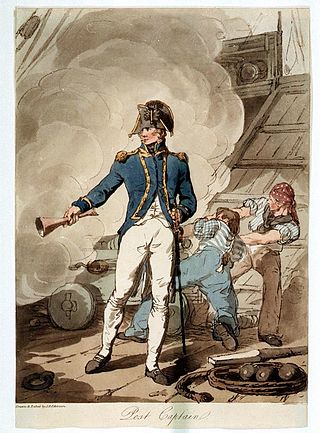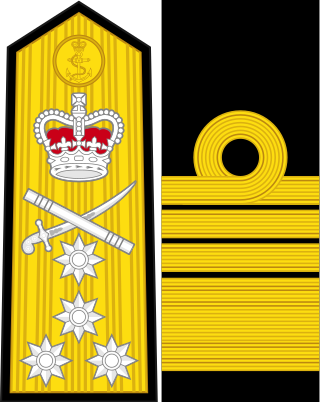Related Research Articles
Commodore is a senior naval rank used in many navies which is equivalent to brigadier or brigadier general and air commodore. It is superior to a navy captain, but below a rear admiral. It is either regarded as the most junior of the flag officers rank or may not hold the jurisdiction of a flag officer at all depending on the officer's appointment. Non-English-speaking nations commonly use the rank of flotilla admiral, counter admiral, or senior captain as an equivalent, although counter admiral may also correspond to rear admiral lower half abbreviated as RDML.

Nikolay Gerasimovich Kuznetsov was a Soviet naval officer who achieved the rank of Admiral of the Fleet of the Soviet Union and served as People's Commissar of the Navy during the Winter War and the Second World War. The N. G. Kuznetsov Naval Academy and the Russian aircraft carrier Admiral Kuznetsov, as well as the Kuznetsov-class carrier class, are named in his honor.

Admiral Samuel Barrington was a Royal Navy officer. Barrington was the fourth son of John Barrington, 1st Viscount Barrington of Beckett Hall at Shrivenham in Berkshire. He enlisted in the navy at the age of 11, and by 1747 had been promoted to post-captain. Barrington had good connections and was lucky to enlist at the right time, and proved to be an able officer.

Post-captain is an obsolete alternative form of the rank of captain in the Royal Navy.

The Home Fleet was a fleet of the Royal Navy that operated from the United Kingdom's territorial waters from 1902 with intervals until 1967. In 1967, it was merged with the Mediterranean Fleet creating the new Western Fleet.

The Soviet Navy was the naval warfare uniform service branch of the Soviet Armed Forces. Often referred to as the Red Fleet, the Soviet Navy made up a large part of the Soviet Union's strategic planning in the event of a conflict with the opposing superpower, the United States, during the Cold War (1945–1991). The Soviet Navy played a large role during the Cold War, either confronting the North Atlantic Treaty Organization in western Europe or power projection to maintain its sphere of influence in eastern Europe.
In the Royal Navy of the 18th and 19th centuries a captain of the fleet could be appointed to assist an admiral when the admiral had ten or more ships to command. The equivalent post was called fleet captain in the U.S. Navy of the 18th and 19th century.
Fleet captain is a historic military title that was bestowed upon a naval officer who served as chief of staff to a flag officer.
A flag officer is a commissioned officer in a nation's armed forces senior enough to be entitled to fly a flag to mark the position from which the officer exercises command.

Admiral is a senior rank of the Royal Navy, which equates to the NATO rank code OF-9, outranked only by the rank of admiral of the fleet. Royal Navy officers holding the ranks of rear admiral, vice admiral and admiral of the fleet are sometimes considered generically to be admirals. The rank of admiral is currently the highest rank to which a serving officer in the Royal Navy can be promoted, admiral of the fleet being in abeyance except for honorary promotions of retired officers and members of the Royal Family.
Commodore (Cdre) is a rank of the Royal Navy above captain and below rear admiral. It has a NATO ranking code of OF-6. The rank is equivalent to brigadier in the British Army and Royal Marines and to air commodore in the Royal Air Force. Commodore has only been a substantive rank in the Royal Navy since 1997. Until then the term denoted a functional position rather than a formal rank, being the title bestowed on the senior officer of a fleet of at least two naval vessels comprising an independent command.
Commodore was an early title and later a rank in the United States Navy, United States Coast Guard and the Confederate States Navy, and also has been a rank in the United States Public Health Service Commissioned Corps and the National Oceanic and Atmospheric Administration Commissioned Officer Corps and its ancestor organizations. For over two centuries, the designation has been given varying levels of authority and formality.

Admiral Sir George Bowyer, 5th and 1st Baronet, was a Royal Navy officer and politician of the eighteenth century. He participated in the Seven Years' War, fighting at the Battle of Minorca, Raid on Rochefort, and Siege of Louisbourg as a junior officer. Promoted to commander in 1761 his first command, the cutter HMS Swift, was captured by the French in June of the following year. Acquitted by his subsequent court martial, Bowyer was promoted to post-captain in October 1762.

Admiral Ram Dass Katari was an Indian Navy Admiral who served as the 3rd Chief of the Naval Staff (CNS) from 22 April 1958 to 4 June 1962. He was the first Indian to hold the office and succeeded the last British officer to the post, Vice Admiral Sir Stephen Hope Carlill.

The First Battlecruiser Squadron was a Royal Navy squadron of battlecruisers that saw service as part of the Grand Fleet during the First World War. It was created in 1909 as the First Cruiser Squadron and was renamed in 1913 to First Battle Cruiser Squadron. It participated in the battles of Heligoland Bight, Dogger Bank and the Battle of Jutland. After the end of the war it became the sole Battlecruiser Squadron.

The First Cruiser Squadron was a Royal Navy squadron of cruisers that saw service as part of the Grand Fleet during World War I, then later as part of the Mediterranean during the Interwar period and World War II. It was first established in 1904 and existed until 1952.

Vice Admiral Nilakanta Krishnan, PVSM, DSC, was a former flag officer in the Indian Navy. He was the Flag Officer Commanding-in-Chief Eastern Naval Command during the 1971 Indo-Pakistani War.

In the United States Navy, United States Coast Guard, United States Public Health Service Commissioned Corps (USPHS), and National Oceanic and Atmospheric Administration Commissioned Officer Corps, captain is the senior-most commissioned officer rank below that of flag officer. The equivalent rank is colonel in the United States Army, Air Force, Space Force, and Marine Corps.
Vice Admiral Elenjikal Chandy Kuruvila, PVSM, AVSM was a former Flag officer in the Indian Navy. He was the Fleet commander of the Western Fleet during the Indo-Pakistani War of 1971, for which he was awarded the Param Vishisht Seva Medal. He later led the Southern Naval Area and then served as the chairman and managing director of Mazagon Dock Limited.
References
- ↑ Rodger, N.A.M. (1986). The Wooden World: An Anatomy of the Georgian Navy. Annapolis, Maryland: Naval Institute Press. p. 19. ISBN 0870219871.